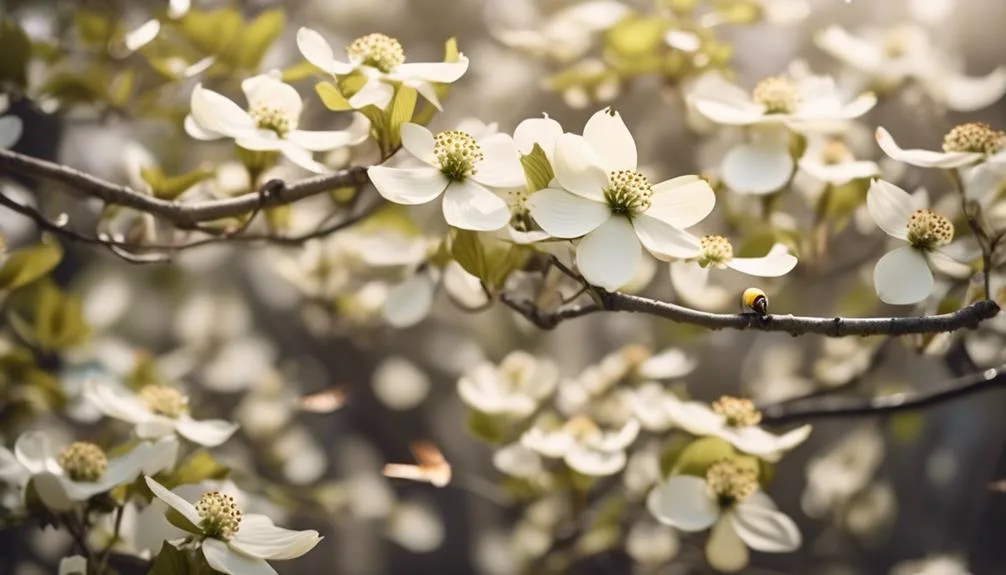Dogwood trees, with their pretty white or pink flowers and red berries, are crucial for local wildlife. They provide food, shelter, aid in pollination, and help prevent erosion.
These trees are vital for the ecosystem and play a significant role in supporting the diverse wildlife in your area. Let's take a closer look at how these graceful trees benefit the wildlife around you.
Food Source for Wildlife
Dogwood trees provide a vital food source for local wildlife, attracting a diverse array of birds, insects, and mammals due to their abundant berries and seeds. The berries are a favorite among songbirds like robins and cardinals, while the seeds are sought after by squirrels and chipmunks. This habitat enhancement plays a crucial role in maintaining ecological balance by providing sustenance for various species throughout the year.
The nutritious berries not only support the wildlife, but also contribute to the overall health of the ecosystem by ensuring a steady food supply. As the wildlife forages on the fruits and seeds of dogwood trees, they aid in seed dispersal, further contributing to the regeneration and diversity of the surrounding flora.
Dogwood trees, therefore, play a vital role in supporting the interconnected web of life within their habitat.
Shelter and Nesting Sites
Providing vital shelter and nesting sites for a variety of local wildlife, the dense foliage and branching structure of dogwood trees create an inviting habitat for birds, small mammals, and insects.
- Wildlife Protection: Dogwood trees offer protection from predators and harsh weather conditions, allowing wildlife to seek refuge within their sturdy branches and dense leaves.
- Habitat Enhancement: The intricate network of branches and leaves provides an ideal environment for birds to build their nests, small mammals to find shelter, and insects to thrive, contributing to the overall biodiversity of the ecosystem.
- Nesting Sites: The sturdy branches and dense foliage of dogwood trees serve as excellent locations for birds to build their nests, providing a safe and secure place for them to lay eggs and raise their young.
These aspects highlight how dogwood trees play a crucial role in supporting and enhancing the local wildlife habitat.
Support for Pollinators
Supporting a diverse array of wildlife, the intricate network of branches and leaves on dogwood trees not only provides shelter and nesting sites but also plays a crucial role in supporting local pollinators.
Dogwood trees offer a vital habitat for pollinators such as bees, butterflies, and hummingbirds. These trees provide nectar, pollen, and shelter for these essential creatures, contributing to habitat restoration and biodiversity promotion in your local ecosystem.
Dogwood blossoms offer a rich source of nectar, attracting pollinators and supporting their populations. By planting dogwood trees in your area, you can actively contribute to the preservation of pollinators and the overall health of the environment.
The presence of these trees in your surroundings won't only enhance the beauty of the landscape but also provide a valuable resource for the pollinators essential for plant reproduction and ecosystem balance.
Erosion Control and Water Management
To effectively manage erosion and water flow in your local environment, incorporating dogwood trees into your landscape can play a pivotal role.
Dogwood trees have extensive root systems that help to hold soil in place, preventing erosion and landslides. Additionally, their thick foliage acts as a natural barrier, reducing the impact of rainfall on the soil.
This not only aids in soil stabilization but also contributes to flood prevention by minimizing surface water runoff.
Furthermore, dogwood trees play a crucial role in watershed protection, helping to maintain the health and functionality of local water systems.
Wildlife Observation and Ecotourism
How can dogwood trees contribute to enhancing wildlife observation and ecotourism in your local area? Dogwood trees play a crucial role in attracting a diverse array of wildlife, making them an essential component of ecotourism and wildlife observation. Their vibrant blossoms and abundant berries attract various bird species, including cardinals, bluebirds, and cedar waxwings, providing excellent opportunities for birdwatching. Additionally, dogwood trees support a rich ecosystem of insects, which in turn attract insectivorous birds and other wildlife. This creates a thriving environment for wildlife observation and ecotourism, driving economic impact through activities such as birdwatching tours and nature hikes. Furthermore, the conservation efforts aimed at preserving dogwood trees and their habitats contribute to the overall sustainability and biodiversity of the local ecosystem.
| Economic Impact | Conservation Efforts | Wildlife Observation |
|---|---|---|
| Nature Tours | Habitat Preservation | Birdwatching |
| Local Businesses | Biodiversity | Wildlife Photography |
| Job Creation | Environmental Stewardship | Ecotourism |
Conclusion
The presence of dogwood trees in the local environment provides essential support for wildlife. They offer food, shelter, nesting sites, and aid in pollination.
In addition, dogwood trees play a crucial role in erosion control and water management. Their roots help stabilize the soil, preventing erosion, and their canopy provides shade, reducing water evaporation and maintaining moisture levels.
These trees contribute significantly to the overall ecosystem. They create a habitat for various animals and insects, supporting biodiversity. The flowers of dogwood trees attract pollinators like bees and butterflies, aiding in the reproduction of other plant species.
Next time you encounter these beautiful trees, take a moment to consider the intricate web of life they sustain and the vital role they play in maintaining a balanced and thriving natural world.

My interest in trees started when I first saw the giant sequoias in Yosemite.
I was a teenager then, and I remember thinking, “I need to learn more about this.”
That moment stuck with me.
A few years later, I went on to study forestry at Michigan Tech.
Since graduating, I’ve worked in a mix of hands-on tree care and community education.
I’ve spent over ten years helping people understand how to plant, maintain, and protect the trees in their neighborhoods.
I don’t see trees as just part of the landscape.
They are living things that make a real difference in our daily lives.
